How to get rid of humidity in an apartment: effective ways to reduce humidity in a living space
High humidity and a feeling of dampness are the scourge of not only private houses, but also city apartments.Even apartments located in modern luxury new buildings very often suffer from high humidity: the favorite place for mold fungi is the lower part of the walls.
A completely logical question arises - what to do in order to prevent such an undesirable phenomenon, ensure a decrease in air humidity in the room and not encounter such a problem in the future.
To answer it, it is necessary to understand the reasons causing the increase in humidity and, if possible, try to reduce their influence.
The content of the article:
Factors causing increased humidity
Unfortunately, eliminating dampness in an apartment building is much more difficult than in a private building - if in the latter it is enough to provide normal ventilation or install thermal insulation materials to solve the problem, then in the case of an apartment everything is much more complicated.
But first, let's look at the most common causes of high humidity in a living space.
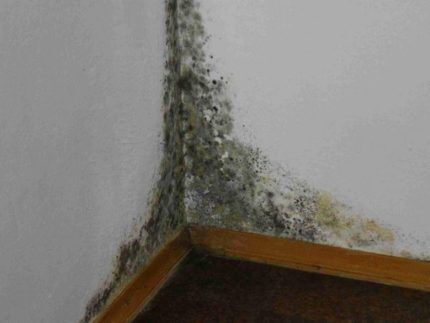
The most common causes of high humidity are:
- Poor quality insulation between the foundation and the wall.
- Leaks in pipes located in the basement.
- Insufficient ventilation. It often happens that the ventilation in the apartment is either poorly adjusted or a priori absent. Most often, the residents themselves prevent normal ventilation by covering the ventilation holes with wallpaper. In addition, it is unsafe and prohibited by housing and communal services standards.
- Unscrupulous neighbors or a leaky roof. And if in the latter case you can at least see traces of water leaks, then the machinations of the neighbors above may physically go unnoticed - unless, of course, there was a full-fledged flood. The thing is that water does not always seep through the ceiling and penetrate into the apartment located on the floor below. Small portions are absorbed by the overlap. Or it may not be missed by a suspended plastic ceiling. It is precisely such situations that create increased humidity with all the ensuing consequences.
- Presence of poorly sealed interwall seams. If during the repair work there were violations, including unfinished finishing and plastering of the walls, you won’t have to wait for normal humidity either.
- Basement flooding. The reason for this can be not only a burst pipe, but also ordinary flooding with melt water. It is enough for the water to stand in the basement for several months, and fungus appears on the first floors.
- Breakage of a wall-mounted pipe. An accident of this kind poses a great danger to the entire house, because there will be dampness not only in the apartment where the leak occurred, but also in all the others.The current situation is also problematic because access to such pipes is difficult - they are located inside boxes, and it will not be possible to quickly determine the location of the leak.
- Incorrect installation of any equipment related to water in one way or another. A constantly running tap or even a banal accumulation of condensation on the toilet cistern - all these things will cause dampness.
Defects that cause high humidity are hidden during the first stages of construction. And, if in the case of private homeownership everything can be corrected, then apartment owners have a more difficult time.
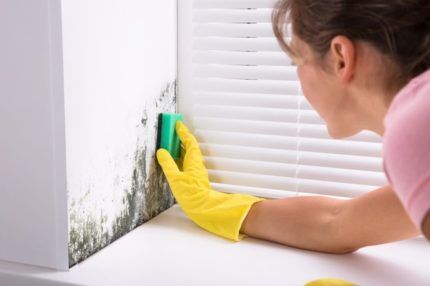
Developers very often make gross mistakes, thus forcing apartment owners to constantly struggle with high humidity and its consequences. Moreover, a long stay in such a room can adversely affect the health of all household members.
The most common diseases that occur in people who stay in apartments with high humidity for a long time are bronchial asthma, tuberculosis and aspergillosis.
In theory, the management company should be involved in eliminating problems of this kind, but not all of them conscientiously treat their obligations.
There is one effective way to identify the source of excess moisture penetration. Take a flat piece of glass and lean it against the wall. Close. After a couple of days, remove the glass.
If, after removal, there is moisture on the surface of the wall against which it was leaning, it means it is penetrating into the apartment from the street.If the surface under the glass remains dry, you need to look for the source of dampness in the walls of the apartment.
We also recommend reading our other article, where we talked in detail aboutinfluence of air humidity on human health.
Effective ways to reduce humidity
And yet, the problem of high humidity in the apartment can be solved. Below we discuss in detail several ways to combat it, which will not be difficult to implement. To achieve the desired result, it makes sense to use several of them simultaneously.
In order to make sure that the air humidity in the room is exceeded, we suggest using the following devices.
Option No. 1 - ventilation of the apartment
The proposed method of air drying is simple and accessible, but at the same time quite effective. Please note that it is necessary to ventilate the room only in dry and windy weather - otherwise the event loses all meaning.
It is especially important to ventilate after cooking, taking water procedures, washing or general cleaning accompanied by use. washing vacuum cleaner.
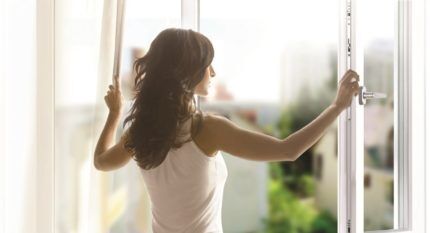
An interesting point about how to reduce the humidity level in an apartment in summer, spring and winter. Everything is very simple - to solve the problem, if the humidity is high, but not too much, a powerful fan will do.
Using this device, you can dry the air in the room - it is not always possible to ventilate it.
Option #2 - heaters and dehumidifiers
If the humidity levels in the room exceed all permissible limits and you constantly feel damp, you will have to think about buying household dehumidifiers. Unlike industrial devices, these are compact and operate silently. And they do not have to work constantly - to successfully combat humidity, it will be enough to turn on the device 2-3 times a week.
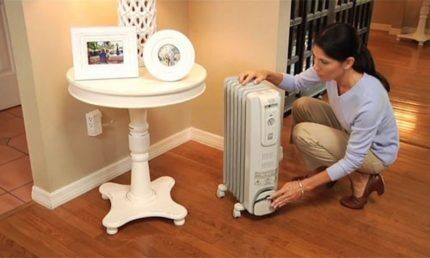
In the cold season and early spring, they provide excellent protection from dampness. heating devices. The heat they generate significantly dries the air - but you need to be careful here, because there is a risk of drying it out.
In order not to overdo it in the fight against high humidity, do not use heaters during the heating season.
Option No. 3 - modern finishing materials
Do you want to provide long-term protection against dampness? Prepare for a major overhaul.
The use of non-natural materials contributes to an increase in humidity in the apartment, so it makes sense, if possible, to avoid the use of plastic and other types of finishes that retain moisture.
Carrying out “drainage” repairs involves performing the following activities:
- Removing remnants of previous finishing.
- Eliminate, if possible, the source of increased dampness.
- Using a heat gun allows you to dry the walls very well.
- Diligently seal all possible sources of high humidity. First of all, you need to pay attention to the joints of the walls and floor seams.For this purpose, the cracks are filled with cement mortar and treated twice hydro- And bioprotective compositions. The most commonly used sealants are silicone based.
- The walls need to be treated with a water-repellent primer or bioprotection. The ideal option is to use both means.
- The prepared room must be finished moisture resistant plasterboard - one that has a green tint. Sheet thickness drywall is about 10–12 mm.
For interior decoration of homes with high humidity, you should use non-woven wallpaper with vinyl coating. This coating effectively resists moisture.
Moreover, when cleaning non-woven You can wipe the wallpaper with a damp cloth. If you don't want to use non-woven wallpaper, compact vinyl wallpaper is suitable.
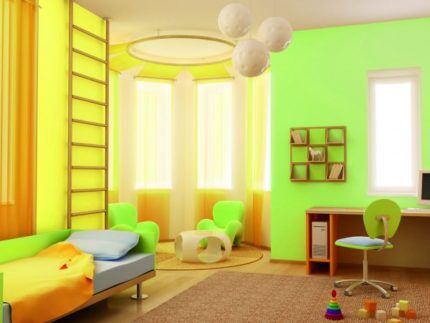
Acrylic paint and putty is a combination ideal for treating walls in rooms with high humidity. Acrylic itself has a high water resistance, and mixed with putty, it provides a reliable water-repellent film.
Another suitable option for decorating wet rooms is ceramic tiles. But its high price limits its scope, so in the vast majority of cases its scope of use is limited to the kitchen and bathroom.
Although, if funds allow, living rooms can also be tiled, only the tiles themselves should be larger in size than those that were used to prevent the increase in humidity in the rooms mentioned above.
Option number 4 - anti-damp tablets
An effective remedy is special absorbent tablets. For example, Ceresit «Stop Moisture", Henkel «Stop Humidity". They are used in conjunction with a desiccant - a container into which the brine solution formed from the absorbed moisture flows. The proposed product can absorb about 0.4 liters of water per month.
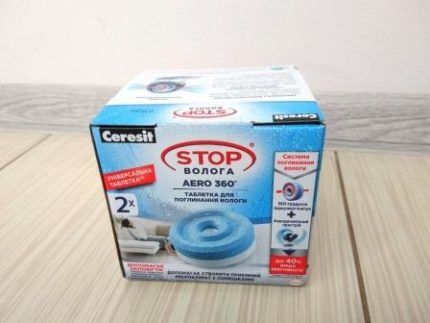
Please note that the area of the room in which the absorbent tablet is used cannot be more than 20 square meters. m. 1 tablet can be used for 2-3 months.
Option No. 5 - folk remedies
If the air humidity in your apartment is slightly exceeded and dampness is not particularly felt, at least it does not lead to fungus.
Or the problem is acute and needs to be solved urgently, but at the moment you do not have enough money to begin a full-fledged repair, you can try to combat high humidity in the room with folk remedies.
Products with absorbent properties
Food products with proven absorption properties are:
- salt;
- sugar;
- rice cereal;
- coffee beans.
It is clear that there is no need to place bags of salt, rice or sugar right in the middle of the rooms.It is enough to pour the products listed above into small containers and place them in inconspicuous places - under the bed, on the chest of drawers, etc.

It should be remembered that the use of sugar as a quality moisture-absorbing means of attracting unwanted neighbors to your home - all kinds of insects like cockroaches, ants, etc., which are much more difficult to combat than high humidity.
Therefore, it is better to use any other products as natural absorbents. By the way, with the help of coffee beans you can make a beautiful decorative composition in a glass thicket - all you need to do is add other bright components there.
Using Silica Gel
Silica gel is a compound whose sachets can be found in many industrial products made from genuine leather (shoes, bags, wallets). The compound perfectly absorbs moisture. The only thing is that to reduce the humidity in the room, the amount of silica gel that you get with shoes and other leather products will clearly not be enough.
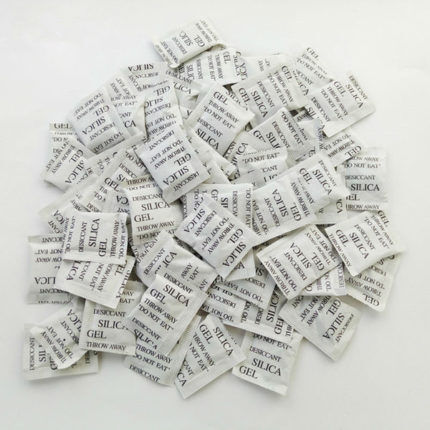
You can buy absorbent at a pet store - they sell silica gel as a component for cat litter. When working with silica gel, be extremely careful: under no circumstances should small children who want to try everything “by tooth” should have access to silica gel balls.
The ideal option is to use silica gel not in bulk, but to spread out fabric bags filled with this material.
Calcium chloride, coal and quicklime
If high humidity is observed exclusively in the non-residential areas of your apartment - pantry, vestibule, balcony, then it is permissible to use the substances listed above as absorbents. But in no case should they be used to reduce the humidity of a residential premises - this can cause a sharp deterioration in the health of household members.
The principle of using the substances listed above as absorbents is extremely simple. Calcium chloride, charcoal and quicklime are poured into containers previously placed in the corners of the damp room.
That's it, nothing else is needed - after six months the composition of the containers will need to be replaced, because the substance will be saturated with moisture to the limit.

The safest option suitable for reducing humidity in living rooms is coal. However, you need to carefully ensure that it does not become a source of coal dust: this will have a detrimental effect on the health of household members.
Choose only large pieces of coal and under no circumstances place coal in walk-through areas. Lime is suitable for reducing humidity on a loggia/glazed balcony. If you are going to use calcium chloride as an inexpensive absorbent, do not forget to thoroughly dry it in the oven before use and then grind it.
Indoor flowers in the fight against humidity
Many people don’t even realize that some plants effectively absorb moisture, so indoor flowers can be used to solve the problem of increased dampness!
So, if you wish, you can combine business with pleasure by having indoor flowers that absorb excess moisture from the air. Please note that not all plants are able to absorb moisture effectively.
Absorbents of natural origin include:
- geranium;
- spathiphyllum;
- fern;
- myrtle;
- lemon;
- a coffee tree;
- Noble laurel;
- syngony.
Only geraniums can be grown at home. Because all the other plants listed above need abundant watering.

Accordingly, they themselves can easily become a source of dampness and even mold in the room. Especially if there are several flower pots on one windowsill.
Recommendations for combating dampness
It is very important to dehumidify the air in the apartment, even if dampness and high humidity itself do not bother you.
The thing is that these conditions contribute to the formation of mold - dangerous fungi, the activity of which can cause serious illnesses in humans, as well as cause damage to property and materials used to decorate the room.
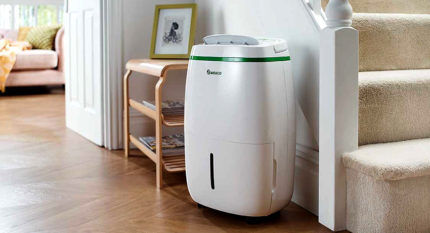
If you have missed the moment and are already struggling not only with the increased level of moisture in the apartment, but also with the consequences of this phenomenon.
Or if you are thinking about carrying out preventive measures aimed at preventing an increase in humidity, it makes sense to follow the tips listed below:
- Do your best to identify the causes of high humidity and try to eliminate them. Otherwise, the fight against increased dampness will be constant;
- be sure to ventilate the rooms after any manipulations that in one way or another involve the abundant use of water - this is true for washing, cooking, and also for hygiene procedures.
- if you don’t want to keep the windows open for a long time in winter, and, by and large, there is no particular need for this - snow getting into the house will not reduce the humidity, the easiest way is to use the “extreme ventilation” tactic - open the windows completely, but only for 2-3 minutes ;
- install a hood and use it daily - at least 30-40 minutes, even if you are not preparing food;
- systematically heat your home during the cold season - at least until the central heating is turned on. Remember: saving on heating is fraught with the appearance of fungus and the need to fight it. Believe me, it is better to dry the air a little than to allow the humidity to increase;
Use plastic double-glazed windows with built-in ventilation - absolute tightness causes a significant oversaturation of the room with moisture.

Using an air conditioner with an air purification function and a humidity control function will also help.
Conclusions and useful video on the topic
How to get rid of humidity in a room using a moisture absorber:
The level of humidity in the room will be discussed in the following video:
An increase in humidity in itself is not as dangerous as the consequences it is fraught with - a constant feeling of dampness, the appearance of fungus, illness in the household and other very unpleasant things. Only an integrated approach to solving the problem makes it possible to normalize the air humidity in the apartment.
Have you ever had problems with high humidity in your living space and how did you manage to cope with them? Please share your experience with our readers. The communication block is located under the article.



